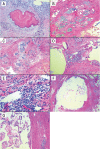The Adult Pancreas in Trauma and Disease
- PMID: 31240039
- PMCID: PMC6490126
- DOI: 10.1177/1925362118781612
The Adult Pancreas in Trauma and Disease
Abstract
The spectrum of traumatic and natural disease that can affect the adult pancreas is multiple and varied. Some entities are more commonly encountered in routine forensic pathology practice and the forensic pathologist needs to be very familiar with their pathological features and development from a pathophysiological perspective. However, many of the conditions are extremely rare and may never be encountered in the professional lifetimes of an individual pathologist. Still, forensic pathologists need to be aware of them in case they are one day faced with these entities as possible diagnoses to be established at postmortem examination. This can be the result of clinical concerns raised in life, potential natural disease explanations for unexpected biochemical results, and sudden, unexpected or otherwise unexplained deaths where criminal concern about the exogenous administration of a substance must be considered. Acad Forensic Pathol. 2018 8(2): 192-218.
Keywords: Alcoholic and obstructive pancreatitis; Chronic pancreatitis; Forensic pathology; Pancreatic injury; Pancreatic trauma; Pancreatitis.
Conflict of interest statement
Disclosures & Declaration of Conflicts of Interest: The author, reviewers, editors, and publication staff do not report any relevant conflicts of interest
Figures
















References
-
- Moore KL. The pancreas In: Clinically-oriented anatomy. 3rd ed Baltimore: Lippincott Williams & Wilkins; 1992. p. 187–9.
-
- Craig MH, Talton DS, Hauser CJ, Poole GV. Pancreatic injuries from blunt trauma. Am Surg. 1995. February; 61(2):125–8. PMID: 7531962. - PubMed
Publication types
LinkOut - more resources
Full Text Sources
